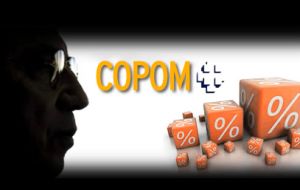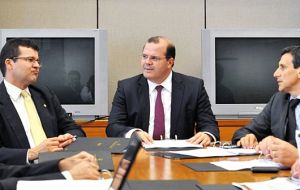MercoPress. South Atlantic News Agency
Brazil central bank increases basic rate to 12,25%, highest since August 2011
 “Considering the macroeconomic outlook and perspectives for inflation, Copom decided unanimously to raise the Selic rate by 0.50 percentage point,”
“Considering the macroeconomic outlook and perspectives for inflation, Copom decided unanimously to raise the Selic rate by 0.50 percentage point,”  Tombini has pledged to do “whatever is necessary” to bring 12-month inflation back to the 4.5% midpoint of the official target range by 2016
Tombini has pledged to do “whatever is necessary” to bring 12-month inflation back to the 4.5% midpoint of the official target range by 2016 Brazil's central bank raised interest rates to a more than three-year high on Wednesday, maintaining an aggressive pace of monetary tightening to contain high inflation, help the economy back on its tracks and win investors disillusioned with the once-booming economy.
In a widely expected move, the central bank's eight-member monetary policy committee, Copom, voted unanimously to raise its benchmark Selic rate by 50 basis points for the second straight time to 12.25%, the highest level since August of 2011.
The tightening cycle that started shortly after President Dilma Rousseff won reelection in October is at the forefront of a bold policy shift to rebuild the country's fundamentals at a time of great uncertainty for emerging market economies.
In an unusually terse statement, the central bank did not give any hints of what it will do next.
“Considering the macroeconomic outlook and perspectives for inflation, Copom decided unanimously to raise the Selic rate by 0.50 percentage point,” said the bank, dropping language in its previous statement on Dec. 3 indicating that future tightening steps would be taken with “parsimony”.
The central bank has promised to do “whatever is necessary” to bring 12-month inflation back to the 4.5% midpoint of the official target range by 2016 despite fears that a series of rate hikes could push the country into recession.
However the road to lower inflation will be a difficult one for Brazil's central bank even as global commodity prices plunge. Although the Rousseff administration plans steep spending cuts this year, hefty hikes in electricity and bus fares are expected to keep inflation well above the midpoint of the official range, between 2.5% and 6.5%.
A string of tax increases announced on Monday to plug a widening fiscal deficit will also keep pressure on inflation.
A combination of more public spending, food price shocks and a sharp depreciation of the Brazilian Real has kept inflation high in the last four years, eroding investor and consumer confidence in an economy that grew an average of 4% a year in the previous decade.
In effect during the eight years of president Lula da Silva, monetary policy was particularly strict under central banker Henrique Meirelles a former Bank of Boston CEO, which helped attract investors.
However when Lula da Silva's handpicked Dilma Rousseff succeeded him the central bank under the current chairman Alexander Tombini implemented a more flexible monetary policy which eventually spurred domestic consumption but also inflation.




Top Comments
Disclaimer & comment rules-

-

-

Read all commentsBrazilians: -Faster your seatbelts, the corrupt government of PT needs money to fix the generalized robbery and increase their funds to remain in power. You pay the bill!”
Jan 22nd, 2015 - 11:12 am 0Mazel Tov Roussef Levy team! Gold and Guns brazilians!
Jan 22nd, 2015 - 03:45 pm 0The hardest hit by all these measures will be the lower class, or, from where most of the PT voters come from. They'll have 4 years to re-think their options.
Jan 22nd, 2015 - 09:30 pm 0Commenting for this story is now closed.
If you have a Facebook account, become a fan and comment on our Facebook Page!